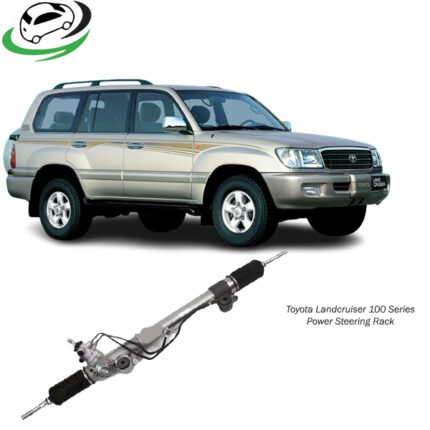-5%
Get Toyota Land Cruiser 100 Series Power Steering Rack 44200-60090
The power steering rack is a critical component of a vehicle’s steering system, providing the driver with the necessary assistance to turn the steering wheel with minimal effort. It plays a vital role in enhancing vehicle control, comfort, and overall driving experience, especially at low speeds and during parking maneuvers. This guide will explore the design, functionality, types, benefits, and maintenance of power steering racks, focusing on their importance in modern vehicles.
Understanding Power Steering
Before delving into the power steering rack, it’s essential to understand the concept of power steering itself. Power steering is a system that helps drivers steer the vehicle by using a power source—either hydraulic or electric—to reduce the effort needed to turn the steering wheel. This system has evolved over the years, transitioning from traditional manual steering to the more common power-assisted steering, providing increased comfort and safety.
Types of Power Steering Systems
There are two main types of power steering systems:
- Hydraulic Power Steering (HPS):
- Hydraulic systems utilize pressurized fluid to assist in steering. When the driver turns the steering wheel, a pump generates hydraulic pressure that moves a piston within the steering rack, effectively providing assistance.
- Components of an HPS system include the power steering pump, steering gear (rack), hydraulic fluid, and hoses.
- Electric Power Steering (EPS):
- EPS systems use an electric motor to provide steering assistance. This system eliminates the need for hydraulic fluid and components, reducing weight and complexity.
- Electric power steering is more energy-efficient and can be easily integrated with advanced driver-assistance systems (ADAS).
The Power Steering Rack
The power steering rack is the heart of the power steering system, responsible for converting the rotational motion of the steering wheel into linear motion that turns the vehicle’s wheels. It consists of several key components:
- Rack and Pinion Gear:
- The core mechanism of the power steering rack is the rack and pinion gear. The pinion gear, attached to the steering column, engages with the rack, which is a long, flat gear.
- When the driver turns the steering wheel, the pinion gear rotates, causing the rack to move side to side. This movement translates to the turning of the vehicle’s wheels.
- Power Assist Mechanism:
- In hydraulic systems, the power assist mechanism consists of a hydraulic cylinder and piston within the rack. The hydraulic pressure generated by the pump assists the movement of the rack, reducing the effort required by the driver.
- In electric systems, the assist is provided by an electric motor that engages when steering assistance is needed.
- End Fittings:
- The ends of the rack connect to tie rods, which in turn connect to the steering knuckles on the vehicle’s wheels. This connection is crucial for translating the linear movement of the rack into rotational movement of the wheels.
- Seals and Bushings:
- Seals prevent fluid leakage in hydraulic systems, while bushings reduce friction and wear between moving parts.
- Sensors (in EPS systems):
- Many modern electric power steering racks are equipped with sensors that monitor the driver’s steering input and vehicle speed. This information is used to adjust the level of assistance provided, improving the driving experience.
Functionality of the Power Steering Rack
The primary function of the power steering rack is to facilitate steering. Here’s how it works:
- Driver Input:
- When the driver turns the steering wheel, this rotational movement is transferred down the steering column to the pinion gear.
- Rack Movement:
- As the pinion gear rotates, it moves the rack side to side. This linear motion is what ultimately turns the vehicle’s front wheels.
- Assistance Mechanism:
- In hydraulic systems, when the driver applies more force to the steering wheel, the power steering pump generates additional hydraulic pressure. This pressure assists the movement of the rack, making it easier for the driver to turn the wheel.
- In electric systems, the electric motor provides assistance based on the steering input and vehicle conditions, ensuring optimal performance.
Benefits of Power Steering Racks
- Ease of Steering:
- The most significant advantage of power steering racks is the reduction in effort required to turn the steering wheel. This is particularly beneficial in tight turns, parking, and low-speed maneuvers.
- Improved Handling:
- Power steering racks enhance vehicle handling and stability, providing more precise control during turns and high-speed driving.
- Comfort:
- With less physical strain on the driver, power steering contributes to a more comfortable driving experience, especially during long journeys or in heavy traffic.
- Safety:
- The ease of steering allows for quicker responses in emergency situations, improving overall vehicle safety. Enhanced control can be critical in avoiding accidents.
- Fuel Efficiency:
- Electric power steering systems are typically more energy-efficient than hydraulic systems, as they only draw power when needed, potentially improving fuel economy.
Maintenance of Power Steering Racks
Proper maintenance of the power steering rack is essential for ensuring optimal performance and longevity. Here are some maintenance tips:
- Regular Fluid Checks (for hydraulic systems):
- Check the power steering fluid level regularly. Low fluid levels can lead to poor steering performance and damage to the system.
- Use the manufacturer-recommended fluid to avoid compatibility issues.
- Inspect for Leaks:
- Regularly inspect the power steering system for leaks, especially around hoses, seals, and the pump. Leaks can lead to a loss of hydraulic pressure, compromising steering assistance.
- Listen for Unusual Noises:
- Pay attention to any unusual noises when steering, such as whining or grinding. These sounds can indicate issues with the pump, rack, or fluid levels.
- Check Steering Response:
- If you notice a change in steering response, such as stiffness or delayed reaction, have the system inspected. These symptoms may indicate a problem with the rack or pump.
- Professional Inspection:
- Schedule regular inspections with a qualified mechanic to ensure all components of the power steering system are functioning correctly. They can identify and address potential issues before they become major problems.
Signs of a Failing Power Steering Rack
Understanding the signs of a failing power steering rack is crucial for early intervention. Some common symptoms include:
- Difficulty Steering:
- If the steering feels stiff or unresponsive, it may indicate a problem with the power steering rack or pump.
- Unusual Noises:
- Whining, clunking, or grinding noises when turning the steering wheel can signal issues within the rack or low fluid levels.
- Fluid Leaks:
- Puddles of fluid under the vehicle or around the power steering components can indicate a leak in the system.
- Vibration or Shaking:
- Excessive vibration or shaking in the steering wheel while driving can be a sign of wear or damage to the rack or associated components.
- Poor Alignment:
- If the vehicle pulls to one side while driving, it could indicate problems with the power steering rack or other alignment issues.
Conclusion
The power steering rack is a crucial component of a vehicle’s steering system, significantly enhancing driving comfort, control, and safety. Understanding its functionality, benefits, and maintenance can help vehicle owners ensure optimal performance and longevity. Regular checks and prompt attention to any signs of trouble will contribute to a smoother driving experience and keep the steering system in top condition. Whether in hydraulic or electric form, the power steering rack remains a vital element in modern automotive design, ensuring drivers can navigate with ease and confidence.
Follow us on Facebook for more parts.




